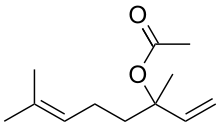Linalyl acetate
Linalyl acetate is a naturally occurring phytochemical found in many flowers and spice plants. It is one of the principal components of the essential oils of bergamot and lavender.[1] Chemically, it is the acetate ester of linalool, and the two often occur in conjunction.
 | |
| Names | |
|---|---|
| IUPAC name
3,7-Dimethylocta-1,6-dien-3-yl acetate | |
| Other names
Bergamiol Bergamol Linalool acetate | |
| Identifiers | |
3D model (JSmol) |
|
| ChEBI | |
| ChEMBL | |
| ChemSpider | |
| ECHA InfoCard | 100.003.743 |
PubChem CID |
|
| UNII | |
CompTox Dashboard (EPA) |
|
| |
| |
| Properties | |
| C12H20O2 | |
| Molar mass | 196.290 g·mol−1 |
| Appearance | Colorless liquid |
| Density | 0.895 g/cm3 |
| Boiling point | 220 °C (428 °F; 493 K) |
| Insoluble | |
| Solubility in ethanol and diethyl ether | Soluble |
| Hazards | |
| Flash point | 69.6 °C (157.3 °F; 342.8 K) |
Except where otherwise noted, data are given for materials in their standard state (at 25 °C [77 °F], 100 kPa). | |
| Infobox references | |
Synthetic linalyl acetate is sometimes used as an adulterant in essential oils to make them more marketable. For example, it may be added to lavandin oil which is then sold as more desirable lavender oil.
The chemical tastes similar to how it smells with a pleasant fruity odor reminiscent of bergamot mint oil. It is found in Eau de Cologne mint and is mildly toxic to humans, toxic to fish, and extremely toxic to daphnia. Linalyl acetate is also combustible.
See also
References
- The Merck Index, 15th Ed. (2013), p. 1022, Monograph 5551, O'Neil: The Royal Society of Chemistry. Available online at: http://www.rsc.org/Merck-Index/monograph/mono1500005551
This article is issued from Wikipedia. The text is licensed under Creative Commons - Attribution - Sharealike. Additional terms may apply for the media files.